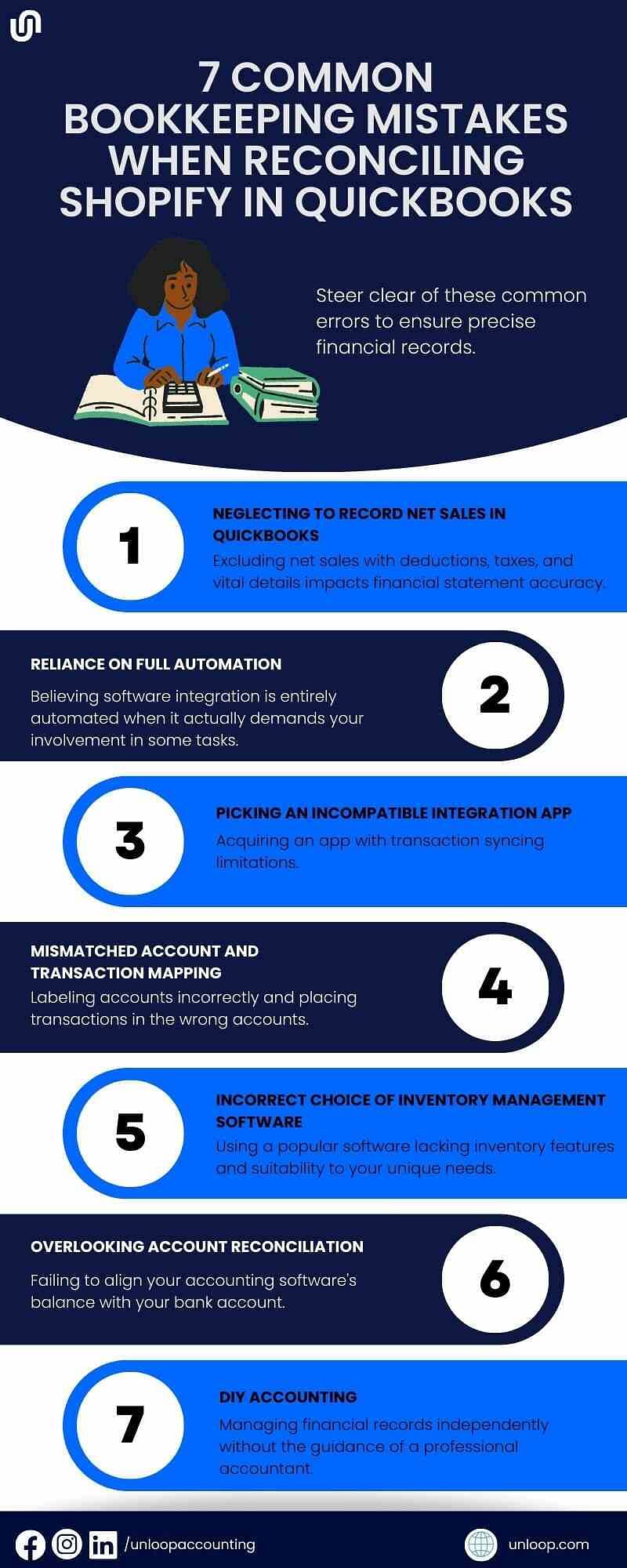
Disclaimer: Please note this article is not financial advice. The purpose of our blog is purely educational, so please consult a professional accountant or financial advisor before making any financial decision.
When running an ecommerce business, it's crucial to know how to reconcile Shopify in QuickBooks to manage it effectively. It means making sure your books are in order. But reconciliation has its own set of challenges that comes with bookkeeping mistakes. For a business owner, it's important to identify and fix them to ensure every puzzle piece fits.
If you have a Shopify store and use QuickBooks Online (QBO) to do your accounting, this article is for you. Let Unloop show you the seven of the biggest Shopify bookkeeping mistakes sellers make when reconciling Shopify transactions to their QuickBooks Online.

Not collecting Shopify net sales that account for deductions, taxes, or other details that provide data about your transactions may result in inaccurate financial records and incomplete insights to analyze.
A Shopify account isn't simply about sales; it should include gross sales before deducting returns, refunds, sales taxes, and deductions. These figures must be analyzed to see what is happening with your online store.
Returns and refunds eat your profits; they can even put you in the red if you're not careful. The same goes for sales tax.
You could overpay or underpay sales tax if you aren't paying attention, and neither is good for your bottom line. Deductions are more complex, but they're any expenses that can be directly attributed to generating revenue.
All these must be in your financial report to get accurate profitability insight. Otherwise, you might think you're doing better than you are or worse, and no one wants that.
You may think that if you connect the Shopify app with your QuickBooks Online, everything will be automatic, and you can set aside accounting tasks altogether. That's far from reality. Among many things, you must reconcile Shopify payments with expenses incurred in the online store and outside of it. It's how you get to the true bottom-line profit.
Always remember that when you integrate Shopify with cloud accounting software, you’re not letting technology do every task. There is a manual reconciliation process involved. The purpose is to make your life easier, so you can spend more time on other important aspects of your online business.
Several apps can migrate a lot of data from Shopify to QuickBooks. Selecting one of these third-party applications allows you to sync over every transaction, sometimes even the unnecessary ones.
New Shopify businesses can adapt to this feature well. Low expenses and sales transactions make it easy to sort through what to keep and discard. But a high-volume Shopify seller should be more diligent with selecting integration apps for efficient accounting and financial reporting.
Alternatively, they can hand over their accounting processes to experts. A team of accounting and bookkeeping professionals has mastered how to manage accounting for Shopify. They know which apps to integrate and can manage volumes of transactions efficiently. It's an excellent resource saver.
Some integrated applications connect Shopify and QuickBooks and automatically reconcile transactions to accounts—these are QuickBooks labels where amounts are recorded for future financial reporting and analysis.
Certain integrations only sync Shopify transactions into a few accounts. This means some of the incoming transactions need to be mapped manually. Shopify merchants must pick this up and map the account and transaction themselves. Incorrectly doing so will affect reporting, bank account reconciliation, and business management.
Most accounting software has inventory-related features. As for most sellers, QuickBooks is their go-to because it’s a superior software for managing accounting processes and seamless inventory management. But depending on your specific needs, this may or may not be the ideal tool for your business.
If you're deep into using QuickBooks as an accounting software, gaps can be bridged by using applications, versions, or add-ons that boost its inventory management capabilities. Accounting experts would know how to make it work for your business.
| 💡 For inventory syncing, the ideal approach is to use cloud inventory software such as Xero or Vend with a multi-channel inventory feature. These software are ideal for a growing business. Otherwise, QuickBooks can work if you're prepared to be more hands-on with your inventory. |
The next blunder is not reconciling transactions in the bank with Shopify data. You may have a Shopify-QuickBooks Online integration, which can accurately record Shopify sales and expenses. But are those net figures identical to your bank account statements? Most likely, they aren’t.
It is frustrating when the accounting numbers don't match the expected business bank account balance. It may be because there's a failure to reconcile bank accounts regularly. While you can connect your bank account to your QBO and sync your Shopify store transactions, some things still need review (e.g., portioning off sales tax from gross income).
Finally, a grave mistake is assuming you can set up and maintain your accounting without the assistance of a qualified ecommerce accountant. Even if you are using excellent cloud accounting software, it won’t yield good results without the hands of an expert.
If you're not well-versed in bookkeeping and accounting, it's better to have an expert by your side to help manage the various Shopify account transactions. Otherwise, you will still be susceptible to issues such as failing tax compliance and messy financial liabilities.

Once you've identified one or several of the mistakes mentioned above, you'll have to fix them as soon as possible to prevent them from creating bigger problems moving forward. Note the following solutions indicated in the table below.
| Double-Check Your Financial RecordsEnsure accurate financial records and comprehensive insights by recording Shopify net sales, gross sales, deductions, taxes, and other transaction details. |
| Verify Shopify and Quickbooks SyncTo reduce errors, always review your Quickbooks sync settings to identify which accounting software features operate with or without automation. |
| Examine Integration Apps Before Using ThemLook at the features of the 3rd party app you’ll use for Shopify-Quickbooks integration. This will help you get an idea of what data it can bring over to your books. |
| Learn Bookkeeping BasicsGrasp basic bookkeeping and accounting principles to align synced Shopify transactions with accurate accounts. |
| Choose a Specialized Inventory SoftwareImprove stock management using specialized inventory software like Fishbowl (if you’re a QuickBooks or Xero user.) |
| Review Business Bank Account StatementsEstablish a reconciling routine by setting a time period, such as a month or a week, to examine line items on your bank statement. Determine how they arrived at the current balance. |
Bookkeeping for Shopify sellers is daunting. You must keep track of all your income and expenses and comply with all the relevant tax laws. You also have to deal with managing inventory, fulfilling shipping orders, and the crucial process of reconciling Shopify with QuickBooks. Altogether, these challenges pose overwhelming responsibilities for Shopify sellers.
Even if you have the table of solutions above, doing all of them on your own is no easy feat. Fortunately, there is a solution to this problem: you can hire a bookkeeper or an accounting firm to handle or help you with most of the work. It will free up your time to focus on scaling your online business and rest easy knowing that your finances are in capable hands.
If you're making or wanting to avoid any of these mistakes, don't worry—you're not alone. We always see this with our clients using QuickBooks Online for their Shopify accounting. So we put together this list to help you identify where you might be going wrong and how to get back on track.
If you think identifying these mistakes and troubleshooting them keeps you away from growing your business, let our team help. Our seasoned ecommerce accountants can assist you in getting your books in order and ensure that your Shopify online store runs as smoothly as possible. Give us a call at 877-421-7270 today.
Unloop is the first and only accounting firm exclusively servicing ecommerce and inventory businesses in the US and Canada. With the power of people and technology, our team dives deep into COGS and inventory accounting. You are paired with a dedicated bookkeeping team that prepares accurate financial statements, financial forecasts, and can also pay bills or run payroll for you. Come tax time, everything is organized and ready to go, so you don't need to worry. Book a call with an ecommerce accountant today to learn more.